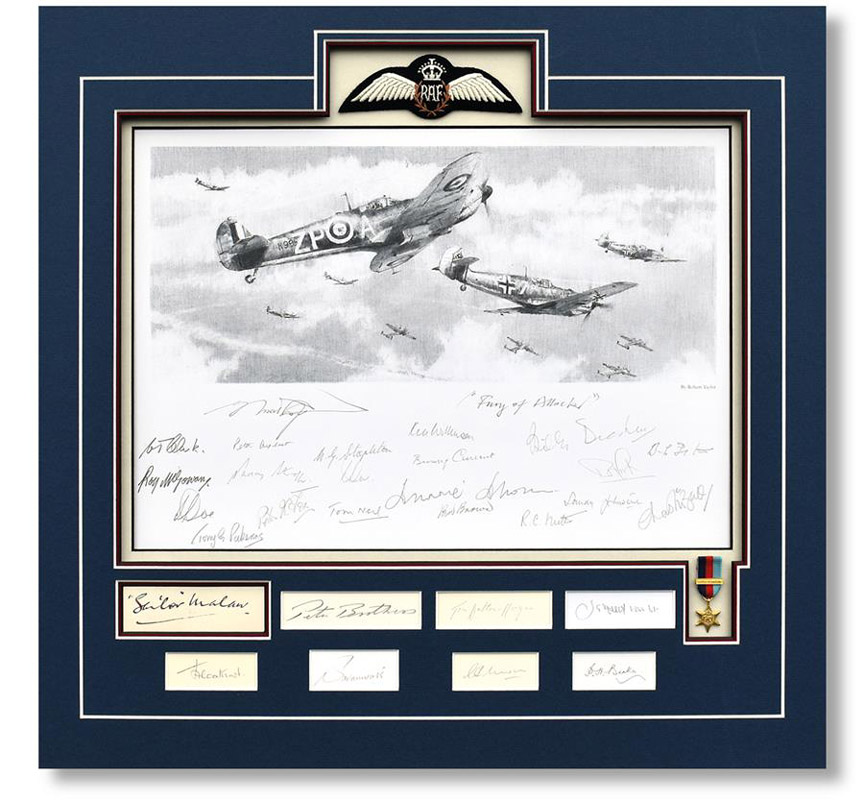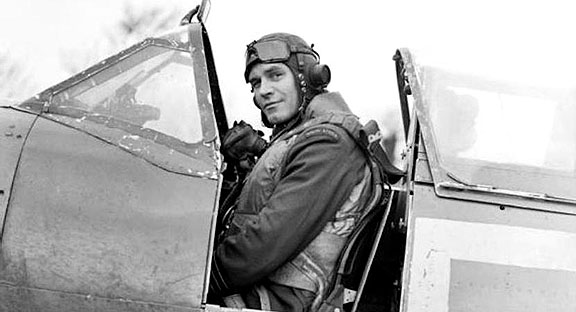

Fury of Attack
by Robert Taylor
| featuring 'Sailor' Malan |
On 7 September 1940 Adolf Hitler, in league with his deputy and Luftwaffe chief Herman Goering, made an irrational blunder, a miscalculation of such magnitude that it would unwittingly lead RAF Fighter Command to snatch victory from the jaws of defeat. Fighter Command was on its knees and close to breaking point; within a matter of days its fighter airfields and radar stations in south-east England were facing obliteration whilst losses of both pilots and machines had become unsustainable. And then, incensed by an RAF bombing raid on Berlin, Hitler demanded revenge – London must be destroyed. The sudden change in tactics, however, gave Fighter Command a few days’ respite to regroup, repair the runways and rush in just enough replacement pilots and machines to at last turn the tide of the battle. This detailed drawing from Robert Taylor continues to reinforce his position as the leading master of aviation art and also continues to inspire our imagination. It’s September 1940 and the Luftwaffe bombers have switched their focus to London but, now reinforced, ready and waiting are the pilots of Fighter Command. In the foreground Squadron Leader ‘Sailor’ Malan leads the charge as the Spitfires of 74 ‘Tiger’ Squadron rip through escorting Bf109s that are doing their best to defend a formation of Luftwaffe Ju88s heading for London. The German bombers are in for another mauling. By the end of the month their raids on London and other big cities had resulted in unsustainable losses to both men and machines. Moreover Hitler’s greedy eyes were now turning east and by the end of October any thoughts of a German invasion of southern England had evaporated. Thanks to the latest printing technology, Robert’s detailed drawing Fury of Attack has been faithfully reproduced on fine art paper which dates back many years and has been personally signed by a staggering nineteen RAF pilots, listed below. |
| Overall size: 20¼" x 20¾" | Available in the following editions | Image size: 6¼" x 15" |
| 7 | Veterans edition | With 30 Battle of Briatin pilot signatures - including Sailor Malan |
| SOLD OUT |
| Signatures (on the print) | |
| Flight Lieutenant Terry Clark DFM AE | Squadron Leader Roy McGowan |
| Wing Commander Bob Doe DSO DFC* | Group Captain Billy Drake DSO DFC* |
| Wing Commander Paddy Barthropp DFC AFC | Wing Commander Tom Neil DFC* AFC AE |
| Squadron Leader Tony Pickering AFC | Flying Officer Ken Wilkinson |
| Squadron Leader Basil ‘Stapme’ Stapleton DFC | Wing Commander ‘Bunny’ Currant |
| Air Vice Marshal J.E. ‘Johnnie’ Johnson CB CBE DSO** DFC* | Flight Lieutenant Bernard Brown |
| Wing Commander Peter Ayerst DFC | Squadron Leader Cyril ‘Bam’ Bamburger |
| Flight Lieutenant Reginald C. Nutter | Warrant Officer Peter Fox |
| Air Vice Marshal ‘Sandy’ Johnstone DFC AE | Wing Commander Bob Foster DFC |
| Squadron Leader Charles Frizzell | |
| Signatures (matted) | |
| Group Captain Sailor Malan DSO* DFC* | Squadron Leader Percival Beake DFC |
| Air Commodore Pete Brothers CBE DSO DFC* | Group Captain Tom Dalton-Morgan DSO DFC* OBE |
| Air Commodore James Leathart CB DSO | Squadron Leader Jocelyn Millard AE |
| Wing Commander George Swanwick | Wing Commander George ‘Grumpy’ Unwin DSO DFM* |
 |
Flight Lieutenant Archie McInnes |
 |
| Adolph Gysbert ‘Sailor’ Malan, DSO & Bar, DFC & Bar (3 October 1910 – 17 September 1963) |
Adolph Malan was born on 3 October 1910 in Wellington, Western Cape. He joined the South African Training Ship General Botha in 1924 or 1925 as a naval cadet which later earned him the nickname ‘Sailor’ amongst his pilot colleagues. In 1935 the RAF started the rapid expansion of its pilot corps, for which Malan volunteered. Following flight training he was sent to join 74 Squadron and by March 1939 he had been promoted to acting flight lieutenant. After fierce fighting over Dunkirk during the evacuation of the British Army on 28 May 1940, Malan was awarded the Distinguished Flying Cross having achieved five kills. During the night of 19/20 June he flew a night sortie in bright moonlight and shot down two Heinkel He 111 Malan and his senior pilots abandoned the Vic formation used by the RAF and turned to a looser formation (the finger-four) similar to the four aircraft Schwarm the Luftwaffe had adopted during the Spanish Civil War. Malan developed the ‘Ten Rules for Air Fighting for fighter pilots’ a set of 10 rules for fighter pilots that were displayed in RAF stations all over the country. On 8 August, at the height of the Battle of Britain, Malan was given command of 74 Squadron and promoted to acting squadron leader. On 11 August, action started at 7 am when the squadron was sent to intercept a raid near Dover, which was followed by three more raids, lasting all day. At the end of that day 74 Squadron had claimed 38 aircraft, it was known from then on as ‘Sailor's August the Eleventh’. On 24 December Malan received the Distinguished Service Order, and on 22 July 1941, a bar to the Order. On 10 March 1941 he was appointed as one of the first wing leaders for the offensive operations that spring and summer, leading the Biggin Hill Wing until mid-August, when he was rested from operations. He finished his active fighter career in 1941 with 27 kills, 7 shared destroyed and 2 unconfirmed, 3 probables and 16 damaged, as one of the highest scoring pilots to have served wholly with Fighter Command during World War II. Most highly regarded by peers such as Douglas Bader, Bob Stanford-Tuck and Alan Deere, Malan was one of the very top flight leaders of the Battle of Britain and a towering figure in military aviation history. |